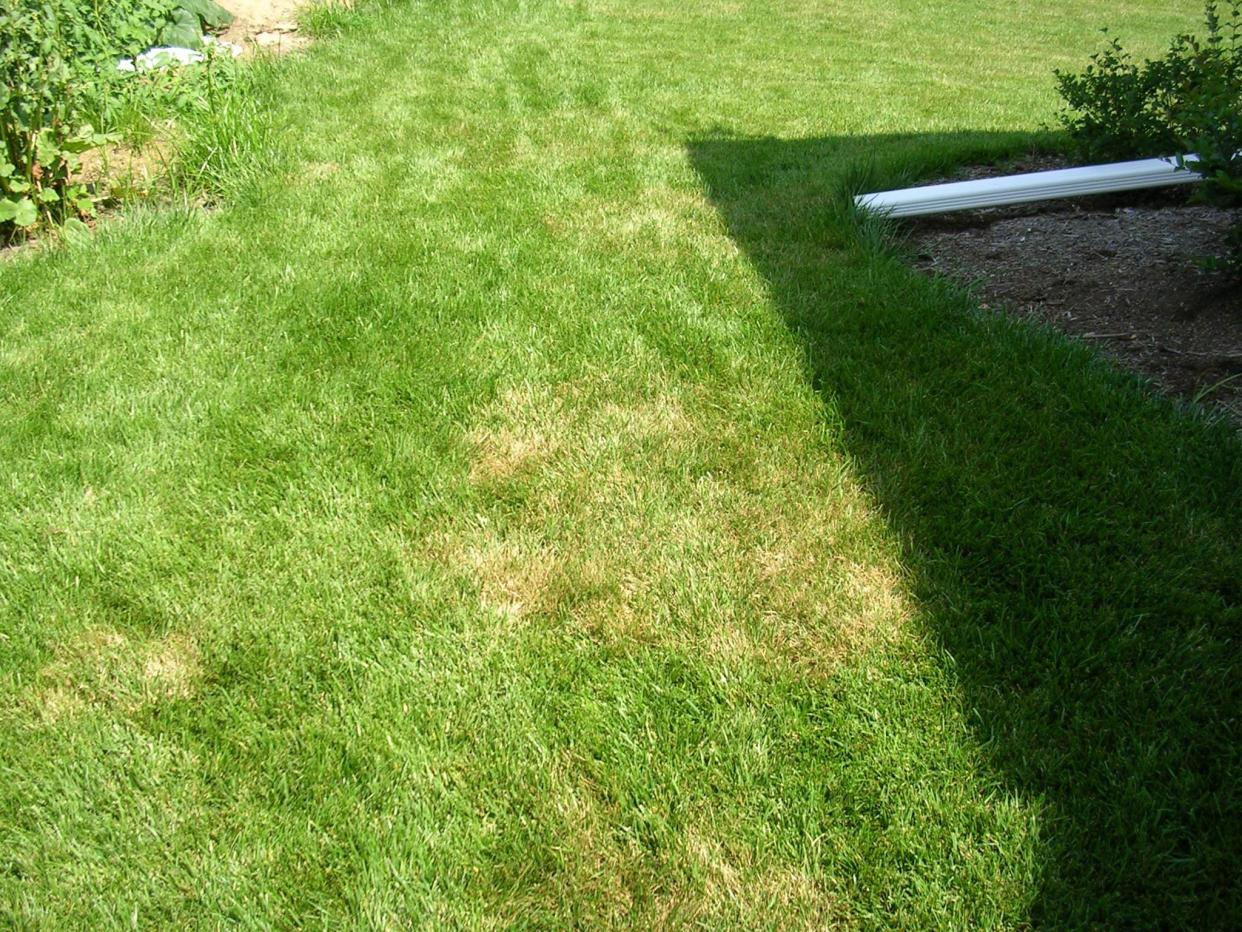Does your lawn have brown patch? You may want to change your watering habits.

Around midsummer, some lawns may develop patches of brown turfgrass. These brown spots are often a fungal disease creatively named brown patch.
Although many things could cause brown spots in your lawn, this disease affects tall fescue, creeping bentgrass and perennial ryegrass most severely. Tall fescue is so susceptible that the disease can kill turf during extended periods of hot, humid weather. Good cultural practices can mitigate most damage caused by brown patch.
Brown patch appears in lawns as rough circles of blighted turf. These circles range in size from a few inches to several feet in diameter. Initially, these patches develop a dark purple-green color. The affected area quickly fades to light tan or brown. These patches may grow and cover large areas of turfgrass.
Some newer tall fescue varieties may turn brown uniformly, without developing circular patches.
Individual plants can also help to distinguish brown patch from other lawn issues. In the earliest stages of the fungal spread, there will be irregular, water-soaked spots on individual grass blades. The spots may have a dark brown border.
Blades of grass with brown patch will have a wilted appearance, even with sufficient soil moisture.
The progression of brown patch is rapid. Large areas of blight may develop within 48 hours. With disease progression, the fungus will attack and kill the crown of the plant. In some cases, turf may recover within a few weeks.
When conditions are more favorable for disease spread, the plants may be killed entirely. Favorable disease conditions are when night temperatures are above 70 degrees with a high relative humidity. Lawns that are given high-nitrogen fertilizers are more susceptible to damage.
There are no tall fescue cultivars with resistance to brown patch. Tall fescue varieties with less damage from brown patch include Adventure, Arid, Falcon, Finelawn I, Jaguar, Olympic and Trident.
Cultural practices can alleviate brown patch issues without resorting to chemical control. Reducing the nitrogen supply helps avoid the incidence of brown patch. Keep the nitrogen levels low or adequate and the phosphorus and potassium levels adequate.
Don’t overfertilize. Most of the nitrogen your lawn needs should be applied in the fall. Anything more than 4 pounds of actual nitrogen per 1,000 square feet per year will predispose the turfgrass to brown patch. Even spring and fall applications of this quantity will increase the likelihood of an occurrence.
Nitrogen should never be applied during an active outbreak of brown patch.
Make sure all your fertilizer applications are done in accordance with a soil test. You may find that your soils need less fertilizer than you are currently applying. Overapplication is also costly and contributes to fertilizer runoff in our waterways.
Another cultural control for brown patch is avoiding late afternoon or evening irrigation. This practice extends the number of hours of leaf wetness and increases the likelihood of fungal development.
The best time to irrigate is between midnight and mid-morning. Turf is normally wet during these early morning hours, so irrigating at those times does not extend the period of leaf wetness. It is also a good practice to alter the frequency of your lawn irrigation with our natural rainfall.
During rainy periods, shift the irrigation schedule in accordance with the rain received. Prolonged periods of rain alone can cause brown patch, but irrigation during periods of rain can exacerbate the issue.

Fungicides can help suppress brown patch, but only if cultural practices have not solved the issue. Preventive applications of Captan, Chlorothalonil, Flutolanil, Azoxystrobin, Propiconazole, Triadmefon and Myclobutanil are reliant control if brown patch has been a continuous issue in your lawn.
Some of these controls are expensive and some products may be restricted use — only available for licensed applicators.
If brown patch develops in your lawn this summer, follow cultural practices to help your turf recover. If hot, humid weather is predicted for significant time after you notice an outbreak, spray applications may help delay the spread.
Brown patch is not always the cause for a brown lawn. Insects, a thick layer of thatch, dogs and poor soil fertility or aeration can all cause similar damage.
Ariel Whitely-Noll is the former horticulture agent for Shawnee County Research and Extension.
This article originally appeared on Topeka Capital-Journal: Change watering, fertilization to help lawn recover from brown patch

